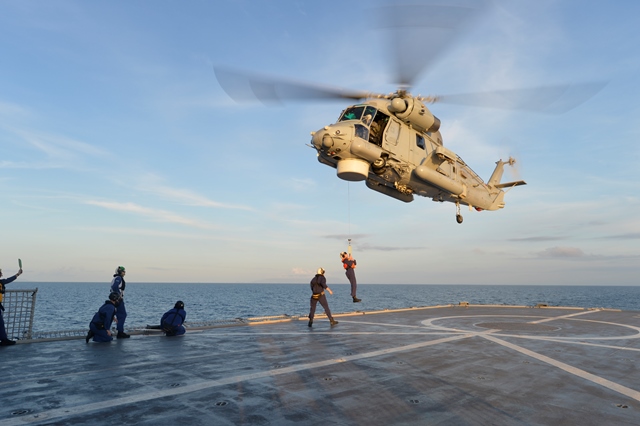A new Maritime Helicopter Replacement (MHR) project has been initiated that will see the Royal New Zealand Navy’s (RNZN’s) existing eight SH-2G(I) Seasprite helicopters replaced from 2027-28.

Published by the New Zealand Ministry of Defence on 24 April, a Request for Information (RFI) has called for details about helicopter platforms that could provide the RNZN the capability to better conduct multi-domain warfare in the littorals.
Roles for the MHR include anti-surface warfare, anti-submarine warfare, joint fires support, Intelligence Surveillance and Reconnaissance, force protection, search and rescue, logistics, casualty evacuation and boarding operations.
A key requirement is interoperability with Australia and other coalition partners. The RFI also wants details about through-life support arrangements, training and mission support. An additional requirement is for a new Uncrewed Aerial System (UAS).
Richard Schmidt, Deputy Secretary, Defence Policy and Planning at the MoD told ADM that the UAS “is viewed as a potential complementary capability to the [MHR] helicopter.” He explained that depending on the task “the UAS may operate alongside the helicopter or it may operate on its own.”
It is not clear if the Seasprites will be replaced on a one-for-one basis. “The number of helicopters and UAS that may be purchased is subject to further analysis before decisions are made. The responses to the RFI will be used to inform this analysis,” Schmidt said, “If selected, [a UAS] is intended to provide options to the Maritime Component Commander to select the right tool for the task.”
READ MORE
- SUPER SEASPRITES
- Navy SH-2G(I) Super Seasprite
- Ministry of Defence sets sights on new maritime helicopters and drones
The RFI indicates that industry estimates for products are presented in July 2025 prices suggesting a contract may be awarded in this timeframe. The Defence Capability Plan 2019 (DCP2019) said a request for tender is due in 2024 and the total cost of the MHR project is more than NZ$1 billion.

Schmidt said that the MoD “is interested in investigating synergies between platforms. This may be through rationalisation of platform types, cockpit functionality, or common systems and spares.” The NZDF also operates the NHI NH 90 Tactical Transport Helicopter and the Leonardo A109 light utility helicopter.
The RNZN’s 6 Squadron, which operates the Seasprites, is closely involved in defining MHR requirements. It does not want to operate and maintain another ‘orphan’ fleet of helicopters that is not used by other countries, as it limits the support network available.
“Defence will evaluate, amongst other criteria, the global fleet, life of type and obsolescence management plans of any proposed replacement capability,” Schmidt said.
The DCP2019 first called for the MHR to replace the Seasprite helicopters. There has been concern in defence circles that the Seasprites may not achieve their out of service dates due to a difficulty in securing spare parts.
Ten Seasprite helicopters were acquired from US manufacturer Kaman Aerospace under a NZ$242.2 million contract signed in March 2013. Originally destined for Australia the aircraft did not enter service and were instead delivered to New Zealand from 2015. Two have been used for spares, but the Seasprite fleet will only have been in-service for little over a decade before they are retired.
The urgency of the MHR is because the Seasprites provide the RNZN with the essential aviation component of its Naval Combat Force (NCF), centred on its two Anzac-class frigates. The NCF represents the NZDF’s only offensive capability alongside the Royal New Zealand Air Force’s (RNZAF’s) new P-8A maritime patrol aircraft.





